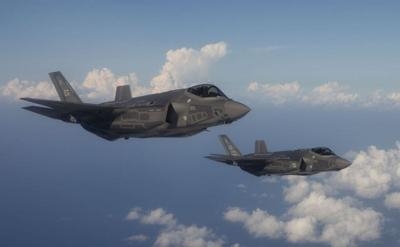Wed, May 17, 2017
Lower Weight Limit Of 136 Pounds Removed After Modifications
Air Force leaders recently removed the restriction that kept pilots weighing less than 136 pounds from flying the F-35A. The restriction was imposed in 2015 due to concerns about the risk during ejections in a portion of the flight envelope.

After rigorous testing to ensure the escape system works reliably and safely in all planned conditions and across all pilot weights, three distinct modifications were implemented. A switch was installed on the seat that slightly delays parachute deployment at high speeds and decreases parachute opening forces for lightweight pilots. Additionally, a head support panel has been mounted on the rear risers of the parachute to prevent the pilot’s head from moving backwards during an ejection. Finally, the overall helmet weight has been reduced through both the reduction of internal strapping material and the removal of an additional external visor, which decreases injury risk during parachute opening.
“I have personally briefed every single F-35 pilot in the United States Air Force about these changes to their ejection seat, and I’m confident our pilots are no longer concerned with the safety of the F-35 ejection system. I've flown in this seat myself and believe, with these modifications, this is the safest ejection seat I've ever flown,” said Brig. Gen. Scott L. Pleus, the F-35 Integration Office director.
In July 2015, during the manufacturer’s ongoing testing, analysis identified an unacceptable risk of neck injury during parachute deployment/opening for pilots weighing less than 136 pounds. The requirement is for the seat to be certified for any pilot weighing between 103 and 245 pounds.
Air Force headquarters and wing leadership took immediate action to ensure pilot safety and work with the manufacturer to meet requirements for the seat. The F-35 Joint Program Office has been working in concert with contractors to develop options to reconfigure the ejection system.
The new ejection seats are already being retrofitted into the existing fleet, and the lightweight helmets are available in pre-production now, while full production starts later this year. The Air Force has received more than 100 F-35As to date, trained more than 400 pilots and accumulated more than 40,000 flight hours.
(Source: USAF news release. Image from file)
More News
Have A Story That NEEDS To Be Featured On Aero-News? Here’s How To Submit A Story To Our Team Some of the greatest new stories ANN has ever covered have been submitted by our>[...]
Cleared For The Option ATC authorization for an aircraft to make a touch-and-go, low approach, missed approach, stop and go, or full stop landing at the discretion of the pilot. It>[...]
“...no entity, whether a division of government or a private company or corporation, may use information broadcast or collected by automatic dependent surveillance-broadcast >[...]
“While our traditional mechanical magnetos will be around for a long time, Hartzell Engine Tech acquired E-MAG to expand its PowerUP Ignition System product portfolio into bo>[...]
Flight Check A call-sign prefix used by FAA aircraft engaged in flight inspection/certification of navigational aids and flight procedures. The word “recorded” may be a>[...]
 ANN FAQ: Submit a News Story!
ANN FAQ: Submit a News Story! ANN's Daily Aero-Term (05.13.25): Cleared For The Option
ANN's Daily Aero-Term (05.13.25): Cleared For The Option Aero-News: Quote of the Day (05.13.25)
Aero-News: Quote of the Day (05.13.25) Aero-News: Quote of the Day (05.14.25)
Aero-News: Quote of the Day (05.14.25) ANN's Daily Aero-Term (05.14.25): Flight Check
ANN's Daily Aero-Term (05.14.25): Flight Check



